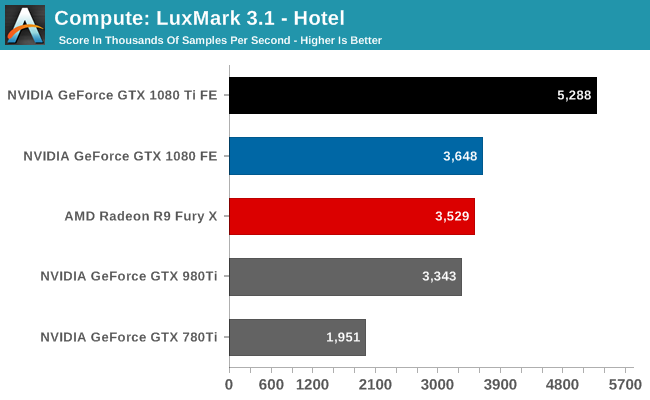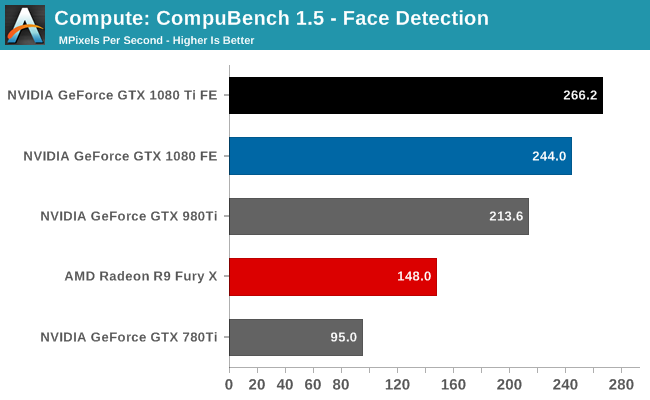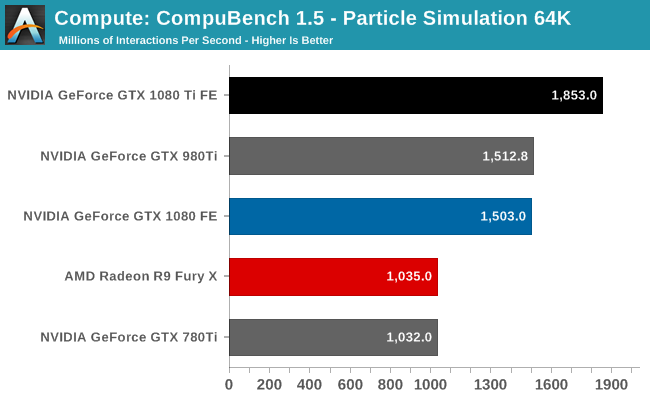The NVIDIA GeForce GTX 1080 Ti Founder's Edition Review: Bigger Pascal for Better Performance
by Ryan Smith on March 9, 2017 9:00 AM ESTCompute
Shifting gears, let’s take a look at compute performance on GTX 1080 Ti.
Starting us off for our look at compute is LuxMark3.1, the latest version of the official benchmark of LuxRender. LuxRender’s GPU-accelerated rendering mode is an OpenCL based ray tracer that forms a part of the larger LuxRender suite. Ray tracing has become a stronghold for GPUs in recent years as ray tracing maps well to GPU pipelines, allowing artists to render scenes much more quickly than with CPUs alone.

The OpenCL situation for NVIDIA right now is a bit weird. The company is in the middle of rolling out OpenCL 2.0 support to their video cards – something that I had actually given up hope on until it happened – and as a result their OpenCL drivers are in a state of flux as company continues to refine their updated driver. The end result is that OpenCL performance has dipped a bit compared to where the GTX 1080 launched at back in May, with said card dropping from 4138 points to 3648 points. Not that the GTX 1080 Ti is too fazed, mind you – it’s still king of the hill by a good degree – but the point is that once NVIDIA gets their drivers sorted out, there’s every reason to believe that NVIDIA can improve their OpenCL performance.
For our second set of compute benchmarks we have CompuBench 1.5, the successor to CLBenchmark. CompuBench offers a wide array of different practical compute workloads, and we’ve decided to focus on face detection, optical flow modeling, and particle simulations.



Like LuxMark, CompuBench shows some minor performance regressions on the GTX 1080 as compared to the card’s launch. None the less, this doesn’t do anything to impede the GTX 1080 Ti’s status as the fastest of the GeForce cards. It dominates every sub-benchmark, including Optical Flow, where the original GTX 1080 was unable to pull away from AMD’s last-generation Radeon R9 Fury X.










161 Comments
View All Comments
theuglyman0war - Sunday, March 12, 2017 - link
Geez developers can't catch a break...I been a registered developer with ATI/AMD and NVIDIA both for years...
Besides the research and papers and tools they invest to further the interest of game development. I have never had to do anything but reap the rewards and say thank you. Maybe there are secret meetings and koolaid I am missing?
Not sure what the actual correct scenario is tell you the truth?
Either triple AAA dev is hamstringing everyone's PC experience because development is all Console centric ( Which means tweaking FOR an "AMD owned architecture landscape" for two solid console cycles where "this console cycle alone sees both BOBCAT and PUMA being supported"! )
Or the Industry is in Nvidia's back pocket because of what? the overwhelming PhysX support? There is an option to turn on Hair in a game? Their driver support is an evil conspiracy?
Whatever... If there is some koolaid I wanna know where that line is? Gimme! I want me some green Koolaid!
theuglyman0war - Sunday, March 12, 2017 - link
Turns out your right! There is a monopoly in game development Software optimization supporting only one hardware platform! Alert the press!http://developer.amd.com/wordpress/media/2012/10/S...
HomeworldFound - Thursday, March 9, 2017 - link
Underhanded deals are part of the industry. Have you ever wondered about the prices even when price fixing is disallowed and supposedly abolished?These deals are always happening, look at the public terms of the deal NVIDIA and Intel.
Nvidia gets:
1.5 Billion Dollars, Over six Years.
6 Year Extension of C2D/AGTL+ Bus License
Access To Unspecified Intel Microprocessor Patents. Denver?
NVIDIA Doesn't Get:
DMI/QPI Bus License; Nehalem/Sandy Bridge Chipsets
x86 License, Including Rights To Make an x86 Emulator
For a company that was supposed to be headed into x86 wouldn't you say that's anti-competitive?
eddman - Friday, March 10, 2017 - link
Prices, I don't know. Isn't it a combination of market demand, (lack of) competition and shortages.What does that deal has to do with this? Not giving certain licenses, publicly, is not the same as actively preventing devs from optimizing for the competition in shadows.
theuglyman0war - Sunday, March 12, 2017 - link
Well there was/is a lot of litigation it seems like admittedly!close - Friday, March 10, 2017 - link
It would not be illegal, it's called "having the market by its bawles". Have you ever actually talked to someone who does this or do you like assuming it's illegal and conspiracy theory (@eddman)?You're thinking about GameWorks and GW is offered to developers under NDA with the agreement prohibiting them from changing the GW libraries in any way or "optimizing" for AMD. And by the time AMD gets their hands on the proper optimizations to put in their drivers it's pretty much too late. Also GW targets all the weaknesses of AMD GPUs like excessive use of tessellation.
But since everywhere you throw a game at you're going to find an Nvidia user (75% market share), game developers realize it's good for business and don't make too much noise.
Nothing is illegal, it's certainly not a conspiracy theory, it may very well be immoral but it's business. And it happens every day, all around you.
eddman - Friday, March 10, 2017 - link
I'm not talking about GPU-bound GW effects that can be disabled in game, and I do know that they are closed-source and cannot be optimized for AMD.I'm talking about whole game codes. Nvidia cannot legally prevent a developer from optimizing the non-GW code of a game (which is the main part) for AMD.
Besides, a lot of GW effects are CPU-only, so it doesn't matter what brand you use in such cases.
ddriver - Friday, March 10, 2017 - link
It cannot legally prevent devs from optimizing for amd, but it can legally cut their generous support.There isn't that much difference between:
"If you optimize for AMD we will stop giving you money" and
"If you optimize for AMD we will stop paying people to help you".
It is practically a combination of bribe and extortion. Both very much illegal.
And that's at studio level, at individual level nvidia can make it pretty much impossible to have a job at a good game studio.
Intel didn't exactly bribe anyone directly either, they just offered discounts. But they were found guilty.
Although if you ask me, intel being found guilty on all continents didn't really serve the purpose of punishing them for their crimes. It was more of a way to allow them to cheaply legalize their monopoly.
An actually punitive action would be fining them the full amount of money they made on their illegal practices, and cutting the company down to its pre-monopoly size. Instead the fines were pretty much modest, even laughably low, a tiny fraction of the money they made on their illegal business practices, and they got to keep the monopoly they build on them as well.
So yeah, some people made some money, the damage done by intel was not undone by any means, and their monopoly built through illegal practices has been washed clean and legal. Now that monopolist is as pure as the driven snow. And it took less than a quarter's worth of average net profit to wipe clean years of abuse.
ddriver - Friday, March 10, 2017 - link
amd was not in the position to make discounts, intel was, so they abused that on exclussive terms for monetary gainsamd is not in the position to sponsor software developers, nvidia is, so they abuse that on exclussive terms for monetary gains
I don't really see a difference between the two. No one was exactly forced to take intel's exclussive discounts either, much like with nvidia's exclusive support and visits to strip clubs and such.
So, by citing intel as precedent, I'd say what nvidia does is VERY MUCH ILLEGAL.
eddman - Friday, March 10, 2017 - link
Then why nothing has happened all these years, for something that seems to be open knowledge among game publishers, developers and GPU manufacturers?A dev asking nvidia for help optimizing a game is not illegal. It is a service. AMD is free to do the same.
What about those games where AMD helped the devs to optimize for their hardware? Was that illegal too? It's either illegal for both or none.
If they've been doing it openly for years and even put their logos in games' loading screens, then it's safe to say it's not illegal at all.